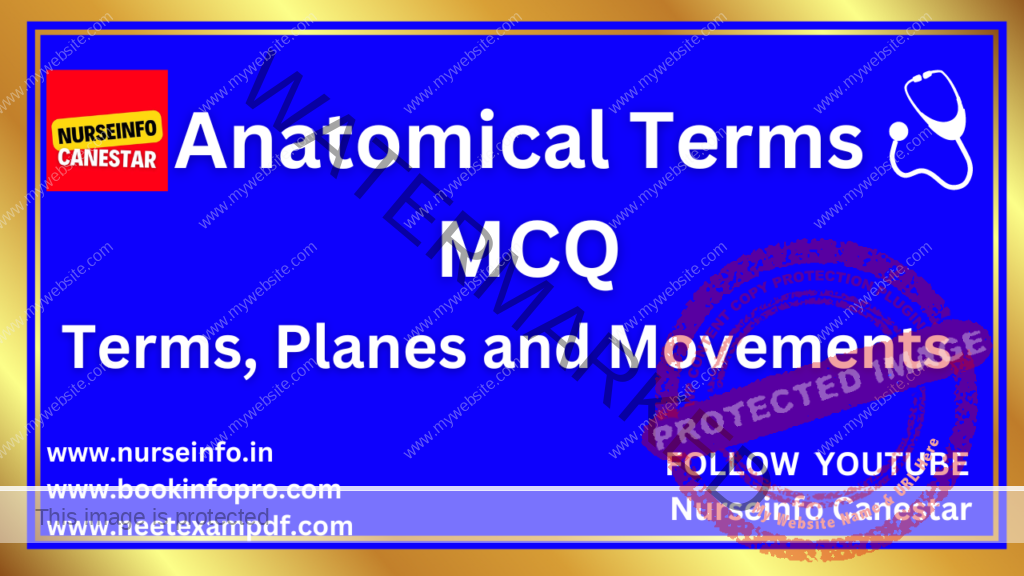Frequently Asked MCQ ON ANATOMICAL TERMS (Terms, Planes and Movements) – ANATOMY
MCQ FOR COMPETITIVE EXAM PREPARATION
These questions given will be useful for competitive exams preparation. We will be updating more mcq regularly, please follow our website regularly.
Which term refers to the front of the body?
A) Dorsal
B) Ventral
C) Superior
D) Inferior
Answer: B) Ventral
The anatomical term “proximal” refers to:
A) Closer to the midline of the body
B) Farther from the point of attachment or origin
C) Closer to the surface of the body
D) Farther from the surface of the body
Answer: A) Closer to the midline of the body
Which plane divides the body into right and left halves?
A) Sagittal plane
B) Coronal plane
C) Transverse plane
D) Frontal plane
Answer: A) Sagittal plane
The anatomical term “inferior” refers to:
A) Toward the head
B) Away from the midline
C) Away from the surface of the body
D) Below or toward the feet
Answer: D) Below or toward the feet
Which term refers to the back of the body?
A) Ventral
B) Anterior
C) Posterior
D) Dorsal
Answer: C) Posterior
The term “ipsilateral” refers to structures:
A) On opposite sides of the body
B) On the same side of the body
C) That are symmetrical
D) Located in the midline of the body
Answer: B) On the same side of the body
Which structure is commonly known as the “windpipe”?
A) Esophagus
B) Trachea
C) Bronchus
D) Larynx
Answer: B) Trachea
The term “plantar” refers to:
A) The sole of the foot
B) The top of the foot
C) The back of the hand
D) The front of the hand
Answer: A) The sole of the foot
The anatomical term “superficial” means:
A) Close to the surface of the body
B) Farther from the surface of the body
C) Closer to the midline of the body
D) Away from the point of attachment
Answer: A) Close to the surface of the body

Which plane divides the body into upper and lower halves?
A) Sagittal plane
B) Coronal plane
C) Transverse plane
D) Frontal plane
Answer: C) Transverse plane
Which plane divides the body into right and left halves?
A) Sagittal plane
B) Coronal plane
C) Transverse plane
D) Frontal plane
Answer: A) Sagittal plane
The transverse plane divides the body into:
A) Superior and inferior portions
B) Anterior and posterior portions
C) Right and left halves
D) Medial and lateral portions
Answer: A) Superior and inferior portions
The coronal plane is also known as the:
A) Transverse plane
B) Frontal plane
C) Sagittal plane
D) Horizontal plane
Answer: B) Frontal plane
Which plane divides the body into anterior and posterior portions?
A) Sagittal plane
B) Coronal plane
C) Transverse plane
D) Diagonal plane
Answer: B) Coronal plane
The midsagittal plane:
A) Divides the body into unequal right and left halves
B) Divides the body into upper and lower halves
C) Passes through the midline of the body, creating equal right and left halves
D) Divides the body into anterior and posterior portions
Answer: C) Passes through the midline of the body, creating equal right and left halves
Which plane divides the body into superior and inferior portions?
A) Sagittal plane
B) Coronal plane
C) Transverse plane
D) Frontal plane
Answer: C) Transverse plane
The horizontal plane is synonymous with the:
A) Sagittal plane
B) Coronal plane
C) Transverse plane
D) Frontal plane
Answer: C) Transverse plane
In a transverse section of the body, structures closer to the head are located in the:
A) Superior portion
B) Inferior portion
C) Anterior portion
D) Posterior portion
Answer: A) Superior portion
Which plane is perpendicular to the ground when a person is standing in the anatomical position?
A) Sagittal plane
B) Coronal plane
C) Transverse plane
D) Oblique plane
Answer: B) Coronal plane
The term “oblique plane” refers to a plane that:
A) Divides the body into superior and inferior portions
B) Divides the body into right and left halves
C) Passes through the body at an angle
D) Divides the body into anterior and posterior portions
Answer: C) Passes through the body at an angle
Which of the following is an example of flexion?
A) Bending the knee to bring the foot closer to the buttocks
B) Spreading the fingers apart
C) Moving the arm away from the body
D) Rotating the head from side to side
Answer: A) Bending the knee to bring the foot closer to the buttocks
Abduction is best described as:
A) Moving a body part toward the midline of the body
B) Straightening a joint to increase the angle between two bones or body parts
C) Moving a body part away from the midline of the body
D) Rotating a body part around its own axis
Answer: C) Moving a body part away from the midline of the body
Rotation refers to:
A) Moving a body part in a circular motion
B) Turning a body part around its own axis
C) Bending a joint to decrease the angle between two bones or body parts
D) Moving a body part away from the midline of the body
Answer: B) Turning a body part around its own axis
Which movement occurs when you lift a cup of coffee to your lips?
A) Extension
B) Flexion
C) Adduction
D) Pronation
Answer: B) Flexion
Supination is best described as:
A) Turning the palm of the hand downward or backward
B) Turning the sole of the foot inward
C) Turning the palm of the hand upward or forward
D) Bending the foot downward at the ankle
Answer: C) Turning the palm of the hand upward or forward
Moving your head to look up at the sky involves which movement?
A) Flexion
B) Extension
C) Abduction
D) Adduction
Answer: B) Extension
When you bring your knees together after spreading them apart, you are performing:
A) Abduction
B) Adduction
C) Flexion
D) Extension
Answer: B) Adduction
Turning your head from side to side involves which movement?
A) Flexion
B) Extension
C) Rotation
D) Abduction
Answer: C) Rotation
Which movement occurs when you move your hand from a palm-up position to a palm-down position?
A) Pronation
B) Supination
C) Eversion
D) Inversion
Answer: A) Pronation
Moving your arm straight out to the side, away from your body, is an example of:
A) Adduction
B) Abduction
C) Flexion
D) Extension
Answer: B) Abduction
FOLLOW YOUTUBE CHANNEL FOR MORE MCQS CLICK HERE


